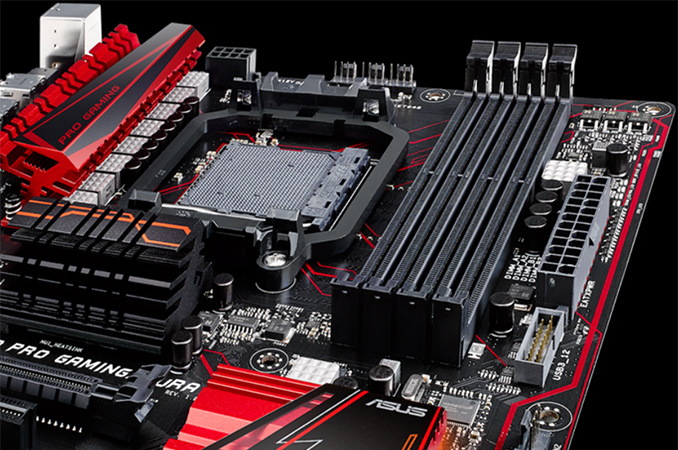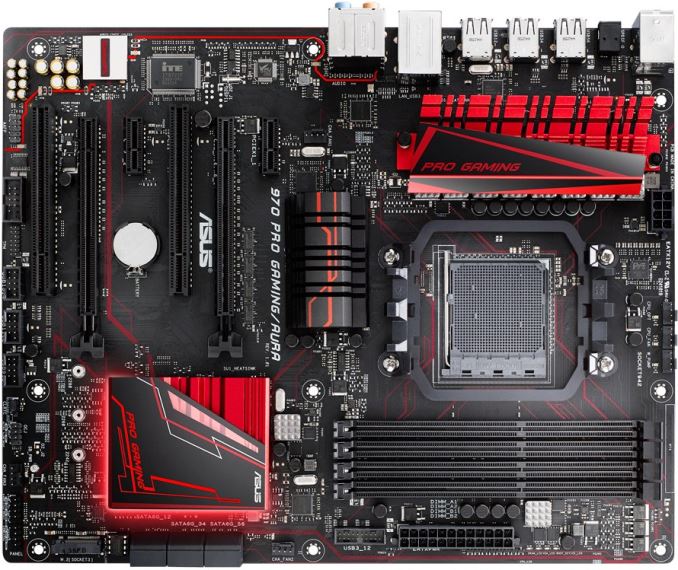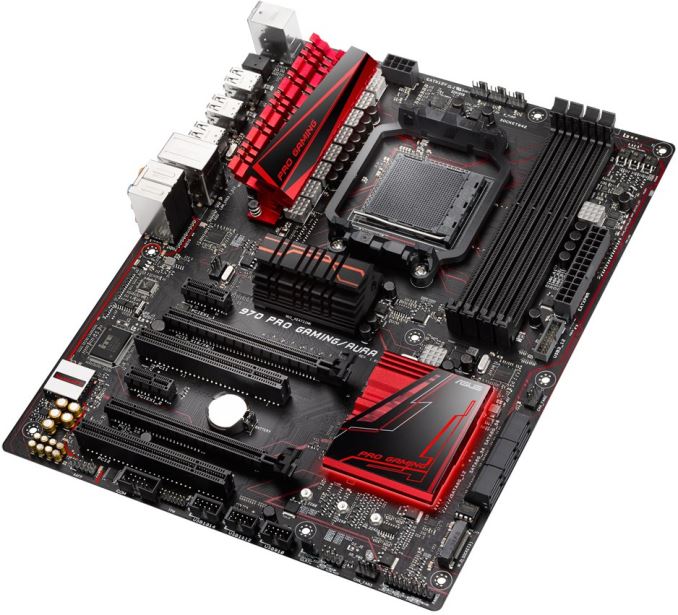ASUS Launches 970 Pro Gaming/Aura Motherboard: USB 3.1 and M.2 to AMD FX Platform
by Anton Shilov on February 2, 2016 1:00 PM EST
ASUS has introduced its latest motherboard for AMD FX microprocessors that brings up-to-date features to the platform. The ASUS 970 Pro Gaming/Aura belongs to a new class of AMD FX (socket AM3+) mainboards that support USB 3.1 peripherals as well as M.2 solid-state drives. In addition, the platform is also equipped with various gaming-oriented features available on the latest platforms from the company.
The ASUS 970 Pro Gaming/Aura is based on the AMD 970 + SB950 chipset, which is not AMD’s top-of-the-range core-logic for the FX processors, but which is pretty affordable for mainstream motherboards. The AMD 970 did not officially support any multi-GPU technology when it was released five years ago. AMD has removed this limitation since then and modern AMD 970-based mainboards, such as the 970 Pro Gaming/Aura, can run more than one video card. The motherboard has two PCI Express slots for graphics cards operating in PCIe 2.0 x8 mode and officially supporting both AMD CrossFire and NVIDIA SLI. In addition, the new mainboard features two PCIe 2.0 x1 and two PCI slots for add-in cards.
| AMD 900 Series Chipsets | |||
| 990FX + SB950 | 990X + SB950 | 970 + SB950 | |
| Code Name | RD990 | RD980 | RX980 |
| Released | Q2 2011 | Q2 2011 | Q2 2011 |
| PCIe Lanes | 42 PCIe 2.0 lanes | 26 PCIe 2.0 lanes | 26 PCIe 2.0 lanes |
| CrossFire | x16 + x16 x8 + x8 + x8 + x8 |
x8 + x8 | x16 + x4 x8 + x8 + x4 |
| SLI | x16 + x16 x16 + x8 + x8 x8 + x8 + x8 + x8 |
x8 + x8 | x8 + x8 |
| NB TDP | 19.6W | 14W | 13.6W |
| HyperTransport (MHz) | 2600 | 2600 | 2400 |
| SATA 6 Gb/s | 6 | 6 | 6 |
| RAID | 0, 1, 5, 10 | 0, 1, 5, 10 | 0, 1, 5, 10 |
| USB 2.0 | 14 | 14 | 14 |
| PCI | Yes | Yes | Yes |
| SB950 TDP | 6W | 6W | 6W |
The ASUS 970 Pro Gaming/Aura supports all AMD FX processors in AM3+ form-factor with up to 125W TDP as well as their predecessors, such as the Phenom II, the Athlon II and the Sempron 100-series chips (but advised against using the 220W FX-9000 series). The new motherboard has upgraded 8-phase power delivery and similar to other ASUS designs the 970 Pro Gaming/Aura uses the company’s Digi+ custom power controller. The motherboard features four memory slots and supports up to 32 GB of DDR3-2133 memory.
The 970 Pro Gaming/Aura comes with six SATA 6 Gb/s ports with RAID 0, 1, 5 and 10 support as well as an M.2 slot for SSDs (2242/2260/2280 form-factors are supported) that operates in PCIe 2.0 x4 mode and supports data-rates of up to 20 GT/s, making it suitable for drives such as the Samsung XP941. The UEFI/BIOS of the motherboard fully supports NVMe protocol and therefore the platform can take advantage of modern SSDs, such as Samsung 950 Pro. However it is unclear whether the M.2 slot uses PCIe lanes from the AMD970 or the SB950 controller. The platform also comes bundled with RAMcache software to speed up launches of frequently used applications.
Meanwhile for USB functionality the motherboard is equipped with ASMedia’s ASM1142 USB 3.1 controller that enables two USB 3.1 type-A connectors on the rear panel. In addition, the mainboard supports two USB 3.0 ports (also using an ASMedia controller) and 14 USB 2.0 ports.
For other functionality we get Intel's I211-AT Gigabit Ethernet controller with the GameFirst software for network traffic prioritization as well as LANGuard ESD and power surge protection. Audio comes through ASUS' SupremeFX, their upgraded Realtek ALC1150 codec solution, with EM shielding, PCB separation of analog/digital signal and support for up to 300 ohms headphones.
The motherboard is designed for low-cost gaming systems, though that hasn't stopped ASUS from adding a set of overclocking features into its BIOS and the components necessary to drive it. The aim is to get a full system price that is competitive. For example, the AMD FX-8320 featuring four Piledriver modules and unlocked multiplier can be purchased for $145, which is comparable to the price of Intel’s dual-core Core i3 processors. Once overclocked, the FX-8320 chip can offer rather decent performance for its price (see our results of the FX-8370E overclocked to 4.8 GHz here). The mainboard also supports AMD CrossFireX, NVIDIA SLI, as well as USB 3.1 and M.2/NVMe, which should attract attention of people seeking for the latest technologies and an easy upgrade path (at least, for graphics).
As an added flair for users that are interested, the ASUS 970 Pro Gaming/Aura also features Aura RGB LED on the south bridge, which can produce various lighting effects, such as pulsating, strobing, fading and so on. The motherboard is clearly not the first affordable platform to offer LED lighting, but ASUS just had to include the technology into the package simply because a number of competing offerings come with LEDs. They can also be switched off if needed.
The ASUS 970 Pro Gaming/Aura has not yet reached retailers, however Newegg already has a listing up for $119.99.
Source: ASUS













25 Comments
View All Comments
MrCommunistGen - Tuesday, February 2, 2016 - link
Though I think this board is quite interesting and it shows how much ingenuity motherboard makers continue to have in this day and age, there's a funny tingle at the back of my mind that can't help but wonder if a product like this will ultimately hamstring whoever buys it.Honestly I'd forgotten that the AMD FX platform was limited to PCI-E 2.0 - It's been that long since the 970 series chipset was released AND it's been that long since I've closely looked at its specifications on paper. Still, as has been shown many times over, this STILL shouldn't significantly affect any current GPU that is given a full 16 lanes - at least not more so than other components in the system. Even the Samsung 950 Pro shouldn't hit any significant bottlenecks assuming it gets a full x4 PCI-E 2.0 (~2.0GB/s) worth of bandwidth on the M.2 port... so the PCI-E 2.0 limitation is not where the funny feeling is coming from.
There are also several definite pros to counteract the potential detractor above. I think that the inclusion of an Intel branded NIC is amazing on a non-Intel platform. Although not revolutionary, even on the AM3+ platform, I appreciate the use of a modern (or at least at this point tried and true) sound solution in the form of the Realtek ALC1150. M.2 support, including NVMe, as well as USB 3.1 help round out what is ultimately an ultra-modern set of connectivity. In fact, each of these positive attributes puts my now aging Z77 board to shame.
I've been trying to figure out what my actual gripe with this platform is as I've been writing this. Ultimately, I think that it's the unoriginal issue that I and most of the enthusiast community have had with the AMD FX platform going on several years now: the Piledriver CPU core. The APU platform got Steamroller (and arguably as of today's announcement they'll be getting Excavator too) and mobile got Excavator through Carrizo. Though neither of those provided revolutionary IPC increases over Piledriver, at least there were increases to be had - some level of progress over the last 3 years to at least alleviate the feeling of stagnation on the compute side of the platform. Better wafer quality, yields, and binning have gotten us some new SKUs, but ultimately someone who'd gotten a well binned, overclockable FX-8350 on launch day in late 2012 is looking at essentially the same CPU choices in early 2016. I guess at this point it just feels sacrilegious to me to mate an ageing CPU with such a modern set of trappings.
Put in another way, I know several people who could use a new desktop computer. Since desktops have such long lifespans these days I'd definitely want a system with modern connectivity. That said, I'd have a hard time recommending a system for the long haul that is starting with an older CPU at its heart - especially when the systems in need of replacement are Sandy Bridge systems with fast dual-core or entry level quad-core CPUs. These users either need or want USB 3.0/3.1, and/or PCI-E NVMe SSDs but are otherwise moderately happy with their CPU performance. In these cases, Piledriver isn't always guaranteed to be a step up, something which I would take as a given for a 4-5 year system upgrade. I guess on the flip side, someone who already has a Bulldozer/Piledriver CPU, and is satisfied with their performance could use this motherboard to modernize their platform connectivity - but then to those users I'd recommend either trying to wait it out to see how Zen reshapes the market, or to see if they can make due with add-in cards.
Ultimately, I'll echo what we're all thinking: "Zen can't come soon enough." When it does I think we'll all be happy to put the tired, overworked, and ageing Bulldozer/Piledriver uArch to bed.
nathanddrews - Tuesday, February 2, 2016 - link
I'm confused as to which is the article and which is the comment... :)Do you really think that "Zen will reshape the market"? They'd have to not only displace a entire Intel segment in performance, but also in volume. I guess I don't see that happening. As a Z77 user, I'm lucky enough to see ASRock release a beta BIOS that adds NVMe boot support, but I'll have to buy an add-in card to get 3.1/Type-C ($30). I probably won't be upgrading until Kaby/Cannon or Zen 2.0... but that remains to be seen.
MrCommunistGen - Tuesday, February 2, 2016 - link
I guess what I meant by that line is that Zen has the potential to provide pricing pressure and potentially also simultaneously offer some level of competition at the enthusiast level. This is something that the current mix of AMD FX/APU struggles to accomplish now.In slightly different words, Zen could provide a viable alternative to Skylake for someone planning to build an enthusiast level rig. By doing so at either a similar or lower price point than Skylake they could potentially help bring down prices from Intel. Failing that, there'd at least be another show in town - something that there arguably *isn't* right now.
ToTTenTranz - Tuesday, February 2, 2016 - link
The chipset is 5 years-old. Which is a minor revision from the 890FX/RD890 chipset, which by itself is a minor revision from the 790FX/RD790 chipset from 2007 (two-thousand and seven).Basically the only thing that changed was support for newer CPU microcodes and other southbridges.
Wow.. we've come a long way...
DigitalFreak - Tuesday, February 2, 2016 - link
We have, AMD hasn't.Oxford Guy - Tuesday, February 2, 2016 - link
Intel has gone backward in some respects. Substandard TIM and weak substrate. Sandy owners are still pleased.StevoLincolnite - Tuesday, February 2, 2016 - link
Sandry Bridge-E @ 5ghz checking in.Why should I spend $1,500 AUD to upgrade to the 5930K+board+ram for minimal performance improvement? (And potentially regressive, due to lower clocks.) ;)
Oxford Guy - Tuesday, February 2, 2016 - link
And Z97 is amazing with its whopping 16 PCI-e lanes.joex4444 - Tuesday, February 2, 2016 - link
Technically Z97 offers 8 PCIe 2.0 lanes, and Z170 offers 20 PCIe lanes. The Haswell and Skylake CPUs offer another 16, bringing it to 24 or 36 lanes respectively. It's also about how they're used: the Haswell's 16 PCIe 3.0 lanes split in CF/SLI would be x8/x8 which is the same as PCIe 2.0 at x16/x16, so Haswell/Skylake offer 16 lanes that have as much bandwidth as 32 lanes on the AMD platforms. Add in the 20 from Z170, and a Z170 + Skylake pairing offers the bandwidth of 52 lanes, more than the 990FX and exactly twice the 970 chipset.I'll grant you that X99 offers much more but is in a totally separate price category with its $350 entry level CPU.
Oxford Guy - Tuesday, February 2, 2016 - link
"The new motherboard has upgraded 8-phase power delivery"Are you certain? I bet it's a doubled 4 phase which seems to be the popular move with these 970 boards. I highly doubt it's a true 8 phase, especially since they said not to use the 9590. A true 8 phase ASUS board should be able to handle one of those.